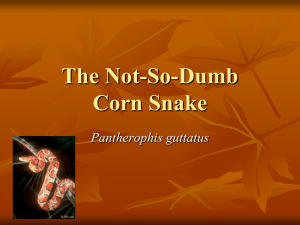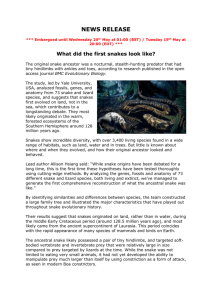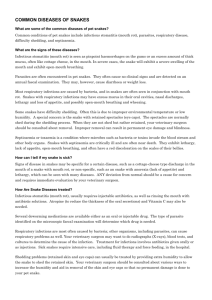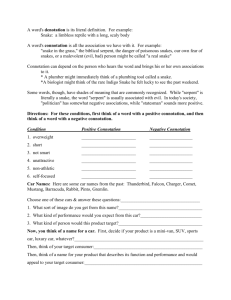ANS 424 2012-03
advertisement
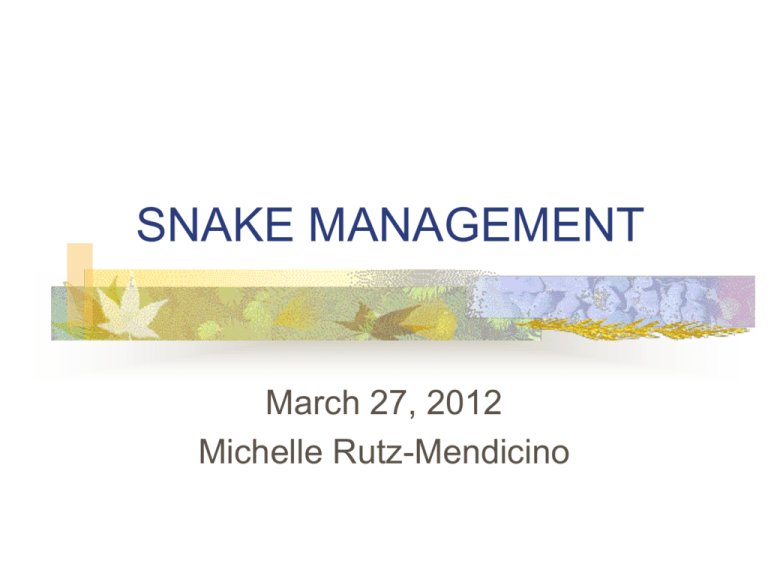
SNAKE MANAGEMENT March 27, 2012 Michelle Rutz-Mendicino SNAKES Habitats - desert to marshes Diets - ovivorous, carnivorous, insectivorous Temperature requirements - widely varied and species dependent Bottom line - do your homework SNAKE CARE Research - Different snakes have different needs Vet - Find one experienced with snakes Housing Secure cage At least as long as the snake Reduces lung infections SNAKE CARE Substrate Sand (+/-) Wood shavings - NOT cedar or pine Newspaper Water Bowl available at all times Must keep clean and change often Needed for shedding and humidity Much of requirement comes from prey SNAKE CARE Heat Lamp or ceramic heater Gradient 70-95° F (highly species dependent) Vertical and horizontal gradients Under-tank heaters, don’t use hot rocks Light All snakes require UV-B 12-16 hours depending on time of year SNAKE CARE Activity Diurnal or Nocturnal Require “hides” and things to climb Other Quarantine of new additions Food – Frozen mice/rats/rabbits/etc.. Weekly (good starting point) Diameter of snake SNAKE CARE Handling Hook - best Tong - harmful to snake Sack/Bag Exit can - for dumping snake from sack Snake Taxonomy Class: Reptilia Order: Squamata Suborder: Serpentes Distinguished from legless lizards No eyelids No external ears Geography and Size Snakes found on all continents but Antartica Found on most islands Ireland’s snakes The last Ice Age, and not St. Patrick Vary widely in size 4 inches to 25 feet Fossil record up to ~50 feet World Record Snake Common Classes Boidae Pythonidae Family of primitive non-venomous snakes comprising Boas and related constrictors Family of large non-venomous snakes comprising many species of ambush predators/constrictors Colubridae Garbage bin family of (usually) non-venomous snakes. Two thirds of all snakes Common Classes Elapidae Family of venomous snakes of the tropics and subtropics; ex Cobra, with hollow fixed fangs United States species Viperidae Family of venomous snakes found world wide (except Antartica). Rattlesnakes and vipers. Boidae Many species Habitat - sandy, semi-arid (for many) Diet - small rodents Non-venomous Brown patterns Sand Boa some have orange Females - 18 inches, 200 gm Males - 15 inches, 70 gm Desert Sand Boa Eryx miliaris Boidae Red Tailed Boa Literally – Boa Constrictor Habitat – South America, tropical Diet – Rodents Non-venomous Characteristic red markings on tail Females – 7-10 ft Males – 6-8 ft Boa constrictor Pythonidae – Ball Python Many color varieties Habitat – Africa, arid, dry Diet – Rodents Non-venomous Very placid and docile Females – 4 – 4.5 ft Males – 3- 3.5 ft Also known as Royal python Python regius Pythonidae – Burmese Python Many color varieties Habitat – Asia, tropic and subtropic, semiaquatic Diet – Large rodents Non-venomous Can reach up to 19 ft! Generally 12 ft Python molurus bivittatus Everglades Invader! Pythonidae – Reticulated Python Many color varieties Habitat – Southeast Asia, tropical, semiaquatic Diet – Large rodents Non-venomous Size – 10-20 ft Largest snake on record! Python reticulatus Colubridae – Corn Snake or Red Rat Snake Many color varieties and patterns Habitat – SE and central U.S. Grasslands, forests Diet – small rodents Non-venomous Size – 3.9 – 6 ft Can live up to 23 yoa Pantherophis guttatus guttatus Colubridae – King Snakes Many color varieties Milk snake is a common species Habitat – Canada to South America Forested regions Diet – small rodents Non-venomous Size – 20 – 60 inches Lampropeltis triangulum SNAKE CARE Temperament Species dependent Ball pythons to reticulated pythons More anxious when shedding and feeding Other characteristics Musking Constricting SNAKE CARE Breeding Live bearers - boa constrictors, water and garter snakes, and rattlesnakes Egg layers – colubrids, pythons Brumation “Cool down” period May require several months Incubation (Highly species dependent!) 78-84 ° F ~ 2 months Cooling Snakes for Breeding Full feed when not cooling (weekly) Separate sexes (optional) Stop feeding for several wks prior to cooling Cool 20 degrees F for ~3 months Light 10-12 hrs Put sexes together; incr. temp to normal; light 13 hrs + 20 min/week to 16 hrs SNAKE CARE Sexing - copperhead hemipenes SNAKE CARE Sexing Size of snake Length of tail from cloaca Hemipenis “cloacal pop” Sexing: Appearance of Snake Unreliable in most species: Leaf-nosed snake of Madagascar Visually sexing Snakes Female tail shorter, stubbier Male tail longer, slimmer SNAKE CARE Sexing “cloacal pop” Only used in young snakes No defined age Harder on older snakes Depends on size of snake Cloacal Eversion “Popping” Snakes have paired hemipenes Long slender hollow tubes Apply gentle pressure with the thumb in a rolling motion from tail tip to the vent Females have similar, but smaller structures Will not “pop” out of the cloaca Ball Python Burmese Python snake hemipenes SNAKE CARE Sexing by probing Female Mexican Hognose snake - Note the lack of hemipenes Probes for sexing snakes Vary in length Vary in diameter Probes for sexing Snakes Gently insert into cloaca Probe in a posterior direction Probing Snakes Lubricate probes Use appropriate size Take care to avoid injury to animal Males: Probe will not insert very far Due to presence of hemipenes Incubation of Snake Eggs 29 to 30˚C or 82 to 85˚F Very species dependent 75 to 85% relative humidity Hatching time – most 55 to 60 days Restraint of Snakes Graduated clear plastic tubes Varying size, length and diameter Safely hold snakes without damaging or traumatizing spine SNAKE CARE Public health Venomous snakes Introduction of invasive species Cage must be locked Responsible for bites Salmonella Venomous (“Hot”) Snakes AVOID Cage must be locked Owner is responsible for ANY accidents Generally, a permit is required State laws Salmonella High proportion of reptiles contaminated with Salmonella Reptiles are NOT appropriate for small children or the elderly Lizards Turtles Snakes All others




